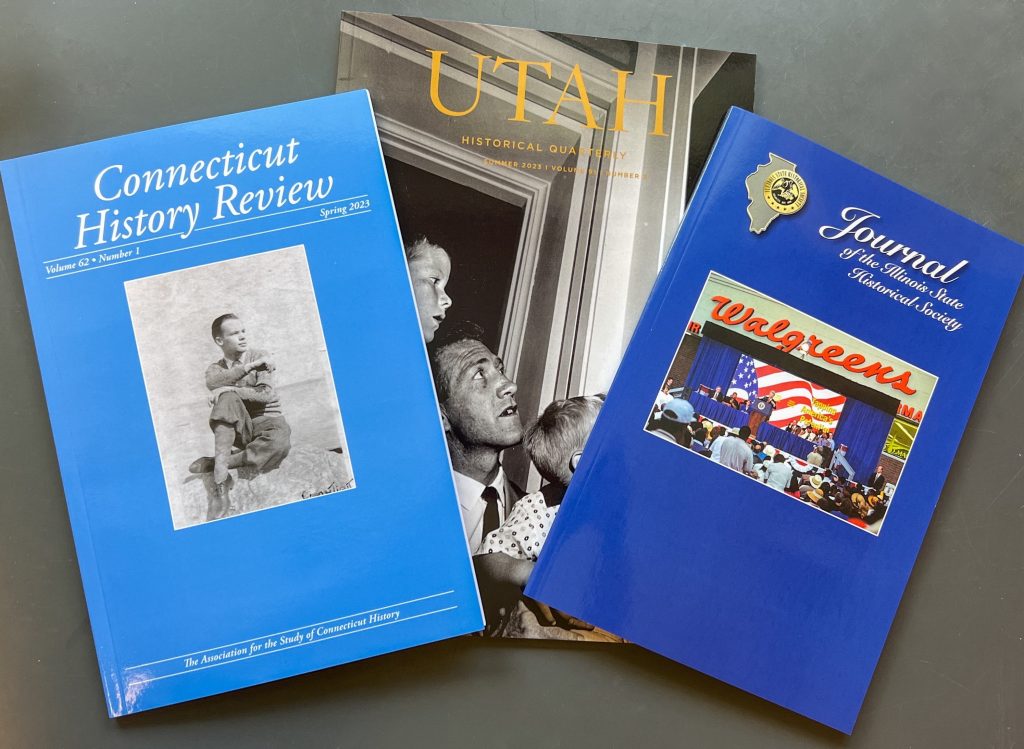
How much do you know about American history? The University of Illinois Press has three different state history journals: Connecticut History Review, Journal of the Illinois State Historical Society, and Utah Historical Quarterly.
Test your trivia knowledge of the three states with the questions below (scroll to the end of the blog for answers!) and learn more with the associated journal articles.
Connecticut
Q1: Salem isn’t the only town in the U.S. with a history tied to witchcraft. On May 26, 1647, more than forty years before trials began in Massachusetts, Alice Young became the first person to be executed for witchcraft in colonial America. Where in Connecticut did the execution take place?
Learn more about the first Connecticut witch trials—from the perspective of a bystander whose life trajectory was changed by Alice’s execution—with “Between God and Satan: Thomas Thornton, Witch-Hunting, and Religious Mission in the English Atlantic World, 1647–1693,” an article by Katherine A. Hermes and Beth M. Caruso in Vol. 61, Iss. 2 of Connecticut History Review: https://scholarlypublishingcollective.org/uip/chr/article/61/2/42/342903/Between-God-and-Satan-Thomas-Thornton-Witch
Q2: Connecticut has one of the highest ratios of stream miles to total area in the Northeast region, most of which are accounted for by three major watersheds. Can you name the watersheds?
Did you know that Connecticut’s streams inspired an early judicial fight over water pollution in the colony? Read “Rivers of Outrage: The Forgotten Fights over Stream Pollution in Late Nineteenth-Century Connecticut, 1880-1925” by William E. Devlin, from Connecticut History Review Vol. 59, Iss. 1: https://scholarlypublishingcollective.org/uip/chr/article/59/1/3/268957/Rivers-of-Outrage-The-Forgotten-Fights-over-Stream
Illinois
Q3: Jack “Greasy Thumb” Guzik was a Chicago gangster who worked in Al Capone’s organization and was important enough that Capone supposedly personally killed someone to protect him. How did he earn his infamous nickname?
Interested in Chicago mob history? Read more about Jack Guzik and his relationship with Al Capone, the most famous gangster in American history, in “’ Greasy Thumb”—The Man Who Made the Chicago Mob’” by James S. Pula, in Vol. 115, Iss. 2-3 of the Journal of the Illinois State Historical Society: https://scholarlypublishingcollective.org/uip/jishs/article/115/2-3/149/320751/Greasy-Thumb-The-an-Who-Made-the-Chicago-Mob
Q4: Early beer brewing in the U.S. was partly motivated by German immigrants’ desire “to make a living and recreate German cultural spaces.” Today, brewers use additives like fruit, sugar, or other flavorings, but due to cultural expectations, early German American brewers had limited options. What were the only three ingredients in proper German beer?
While beer might initially seem unrelated to Illinois state history, Braden Neihart tracks the drink’s regional history in “Capitalism, Protectionism, and Beer Wars in Rock Island, 1880–1900,” published in the Journal of Illinois State Historical Society, Vol. 115, Iss. 2-3: https://scholarlypublishingcollective.org/uip/jishs/article/115/2-3/132/320744/Capitalism-Protectionism-and-Beer-Wars-in-Rock
Utah
Q5: In what year were women in Utah first able to vote?
You might be familiar with suffragists working in Seneca Falls, but do you know about the activists in Utah and the unique history of women’s suffrage in the state? Katherine Kitterman breaks down this history in her article, “First to Vote: Commemorating Utah’s Suffragists,” from Vol. 88, Iss. 4 of Utah Historical Quarterly: https://scholarlypublishingcollective.org/uip/uhq/article/88/4/270/202470/First-to-Vote-Commemorating-Utah-s-Suffragists
Q6: The development of motels was a large part of the history of the American West in the 20th century, spurred by the expansion of highways and boosting the tourist economy. However, they weren’t the first form of highway hospitality in the U.S. What was the predecessor to the highway motel?
Dive deep into the history of Utah motels with Susan S. Rugh in her article, “Motel Builders of the Modern West,” featured in Vol. 90, Iss. 4 of Utah Historical Quarterly: https://scholarlypublishingcollective.org/uip/uhq/article/90/4/260/320611/Motel-Builders-of-the-Modern-West
ANSWERS
A1: Windsor, CT. The residents of the area were recovering from a flu epidemic at the time, a circumstance that has historically heightened fears of witches, and Alice’s execution would spark paranoia in the area for decades.
A2: As Devlin writes in his article, the Connecticut watersheds include “the broad Connecticut River valley and its tributaries in the center of the state, flanked by watersheds that drain highland regions: the Housatonic system in the west, and the Quinebaug/Thames system in the east” (5).
A3: He paid off local politicians and officials for Capone. As Pula writes, “It was undoubtedly Guzik’s role in greasing the palms of Chicago’s influential by rapidly peeling off large denomination paper currency from the huge wad he kept in his pocket that earned him the sobriquet ‘Greasy Thumb’” (154).
A4: Water, barley, and hops, as dictated in “The Reinheitsgebot, a series of German purity regulations passed in 1516” (Neihart 136).
A5: 1870, almost fifty years before the 19th Amendment passed! To be more specific, Seraph Young become the first woman in the United States to cast a vote under a Utah women’s equal suffrage law on February 14, 1870. Utah women were later disenfranchised by Congress in 1887, but won their voting rights back again before the 19th Amendment with a clause in Utah’s 1896 state constitution that also allowed them to hold political office.
A6: They were called tourist courts, consisting of groups of cabins around a gas station with an open court facing the highway. One writer referred to them as “the highway’s slum structures, the corn cribs and chicken coops called, offensively to our patriotic tradition, ‘Cabins’” (Rugh 262).
